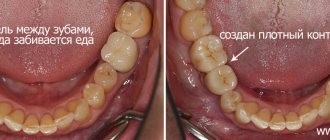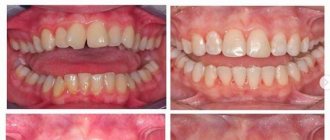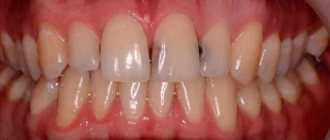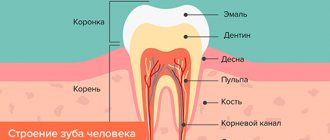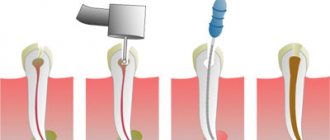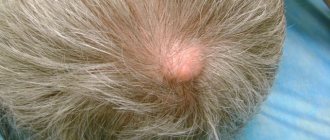Many parents are concerned about the question: how to remove the gap between the child’s teeth, especially in cases where it causes problems with diction? And this is absolutely correct, because if you leave everything as it is and do not remove the gap between the teeth, then in the future it may cause serious and unpleasant problems. That is why diastema (that’s what doctors call the gap) should be resolved in childhood. It is known that the bone tissue in children is not yet fully formed, so any manipulations to correct the position of the teeth are faster and easier to tolerate at an early age.
If the diastema, or gap between your child’s teeth, is pronounced, schedule your child to see a Mira dentist for a consultation. The doctor will talk about the causes of this phenomenon, possible consequences, as well as ways to eliminate the gap.
The causes of diastema are controversial. There are a number of hereditary genetic prerequisites for the occurrence of a large distance between the front teeth. Also, some features of the structure of the oral cavity directly affect the occurrence of diastema: a defect in the frenulum of the lips, large interdental papillae, problems with the replacement of baby teeth with permanent ones, incorrect position of the teeth, pathologies of the teeth and gums.
As a rule, regular dental care from the first months of a baby’s life helps to avoid the formation of a large gap between the teeth - a diastema. In addition, it is very important to monitor the child’s oral hygiene and promptly teach him to take care of his teeth on his own. To prevent dental problems, it is recommended to pay attention to a proper diet rich in vitamins. This will protect the baby from the development of possible pathologies, prevent caries and avoid periodontitis, which are very likely with the appearance of a gap.
Gap between teeth - diastema
Diastema is a fairly common phenomenon. In adults, you can often notice a gap, expressed to a greater or lesser extent. Statistics show that literally every second baby is at risk of developing a gap between the front teeth.
If the gap between the upper or lower front teeth is more than 1 mm and varies in width up to 10 mm (most often the limit is 2–6 mm), we can confidently speak of a diastema. The spaces between other teeth have another name - trema.
Due to the formation of a gap, all sorts of inconveniences arise in the implementation of everyday and vital functions. Diastema complicates the normal process of eating and affects diction, so if there is a sufficiently pronounced gap, the child speaks poorly. In addition, the gap is an additional stimulus for the occurrence of caries and periodontitis.
There is a classification of diastemas, including false ones: this involves the presence of a gap between the baby teeth, which naturally disappears during the change of teeth to molars.
If a gap occurs after the appearance of permanent teeth, measures should be taken to eliminate it as soon as possible. And although dentists eliminate diastema even in adulthood, it is most comfortable to carry out treatment in childhood.
What kind of gap could there be? The main division assumes the existence of symmetrical and asymmetrical diastemas. In the first case, the upper or lower incisors are at an equal distance from each other. In the second, only one tooth has an incorrect position, while the second remains in its rightful place.
Also, the spaces between the teeth can be conditionally divided according to the direction of growth of the incisors. The gap can be caused by the divergence of the incisors in different directions with parallel roots (lateral deviation of the crowns) or by a divergence starting from the roots (corpus lateral displacement).
In addition, a so-called medial tilt is possible, when teeth grow with rotation around their axis or have a clear direction to the side.
Is it worth fixing this violation?
Is treatment necessary, especially for a teenager? From an aesthetic point of view, not everyone perceives a diastema as a defect, especially if it is small, but the primary task of orthodontics is to maintain dental health. Therefore, even if there are no complaints about the appearance of the teeth, the orthodontist will still recommend correction.
In most cases, in addition to the diastema, there are other disorders, since, in principle, very few people have perfectly straight, correctly intersecting teeth. Therefore, the treatment will definitely not be “excessive” - in parallel with diastemas, other defects will be eliminated.
Diastema is often combined with other disorders
Ways to correct a gap between a child's teeth
Eliminating diastema is not so difficult. The many ways to correct gaps between a child's teeth give parents and dentists a wide range of choices. Depending on the width of the gap, individual characteristics and financial capabilities, correcting the anomaly will take some time (from 1 procedure to several years). Among the treatment options for diastema, you will see the most common dental procedures. So, below we present a list of methods for returning teeth to their natural healthy position.
Braces are considered the most common and widely available way to correct a malocclusion. Gradual straightening of the teeth allows the gap to be eliminated. It is best to install braces in childhood, since bone tissue is at the stage of formation and is easier to change. If you install braces in adulthood, you need to be prepared for the fact that after completing the course of wearing braces, you will need to wear a retainer for a long time to consolidate the effect and rebuild muscle memory.
Braces to eliminate gaps between the front incisors are a safe and gentle way to achieve a beautiful, straight smile.
Another way to correct the position of teeth is plates . They belong to the category of removable structures and are designed mainly to be worn by children under 12 years of age. The removable nature of the plates simplifies the process of orthodontic treatment compared to braces, however, if the gap between the incisors is large, the plates will not bring the desired effect.
mouthguards are the dream of many patients, because they are made of transparent material individually in each case and are designed to be worn for several hours a day. Clear aligners have the same effect as braces and plates, but are not suitable for severe overbites.
Another method is to install veneers and crowns on the front teeth. This solution to the problem of diastema does not require a long process of correcting the bite. In this case, the dentist selects a shade of veneers that completely matches the natural shade of the patient’s tooth enamel, which makes the teeth straight and well-groomed, closing the unaesthetic gap. Before installing veneers, you will have to carry out some preparatory work - grinding the teeth.
If the diastema is mild, the dentist may suggest improving the quality of your smile with a cosmetic filling that reduces the gap between the teeth. There is a more aesthetic and modern way to eliminate the gap - artistic restoration. It consists of building up teeth using a composite filling material. After such procedures, care must be taken when chewing hard food and actively using the front teeth while eating.
If the cause of the diastema is an anomaly in the frenulum of the upper lip, an operation to plasticize it is necessary, and then correct the position of the teeth or mask the gap in any way.
Periodontal treatment
Sometimes the formation of a gap in the front teeth is directly related to periodontal disease. In this case, undergoing treatment from specialist periodontists is a mandatory procedure. After gum health returns to normal, braces are used to help move the teeth into place. In more complex situations, a bridge is used to close large gaps. Periodontal correction leads to the formation of normal contact between teeth.
The methods listed above are the most common in the treatment of diastema. Of course, each technique has its own advantages and disadvantages, but in general it is effective and allows you to permanently eliminate the problem that is tormenting the patient. Patients with diastema should be aware of the specific treatment options available and choose the most appropriate ones based on their own medical history.
View prices
Making an appointment with a dentist
Cost of correcting diastema
It is easy to guess that the cost of correcting a diastema depends on the chosen method and the need to use certain materials. The severity of the defect also matters.
In general, the most affordable way to achieve a beautiful smile is cosmetic correction or surgical plastic surgery. Artistic restoration, braces and other methods of correcting the position of teeth will be more expensive, but the cost of these methods remains affordable for most patients. When it comes to mouthguards, their production will be the most expensive.
Symptoms and diagnosis
Most children up to one year and later have no symptoms of diastema. Despite the fact that the peculiarity of the formation of the jaw is visible during personal contact, the patient does not experience discomfort and does not express complaints.
When a gap between teeth occurs due to frenulum or periodontal pathologies, over time the patient develops characteristic symptoms. Children complain of pain during chewing, and the baby is unable to fully latch onto the mother's breast. With age, gum bleeding and discomfort appear.
What will be the consequences if the gap between the teeth is not corrected?
Will the child face consequences if the gap between the teeth is not corrected? It is impossible to answer unequivocally. During the consultation, the dentist will assess the degree of development of the diastema and correlate this with a number of other factors. However, it is impossible to accurately predict the consequences. The gap may not manifest itself in any way throughout life, but serious consequences cannot be ruled out. The diastema can expand and cause problems with bite and diction. If your child is already burring, then it makes sense to work on eliminating the diastema instead of trying to solve the diction problem with a speech therapist.
With age, the load on teeth increases, especially if they are incorrectly positioned in a row. This easily leads to caries and can cause periodontitis. An incorrect bite often results in teeth that are loose, painful, worn down, and at risk for infection and inflammation.
Therefore, in order to protect your child from frequent visits to the clinic in the future, take care of the position of his teeth today.
Reasons for the anomaly
A large distance between the front teeth can appear due to various factors:
- too small teeth with a large jaw volume;
- intrauterine disorders during the formation of the dentition;
- a large frenulum that connects the inner surface of the lip and gum;
- formation of an incorrect swallowing reflex (if during swallowing the tongue rests on the front teeth);
- bad habits that develop in childhood (prolonged use of pacifiers, bottles and other means);
- periodontal diseases, as a result of which the volume of bone tissue decreases;
- incomplete use of the braces system, when teeth move apart due to failure of the retention period;
- functional changes in children during the formation of temporary occlusion.
Mouth breathing
If you find that your child predominantly breathes through his mouth or snores at night, I advise you to immediately contact an ENT doctor first and foremost. Orthodontic measures for oral breathing in children can begin at 3-4 years of age. Mouth breathing in children leads to a violation of the position of the tongue: the tongue moves down the oral cavity and ceases to occupy the desired position. So it does not have a stimulating effect on the upper jaw - and it does not develop to the required extent. As a result, there is not enough space for permanent teeth, and they begin to grow unevenly. In addition, a narrow upper jaw can cause a habitual lateral displacement of the lower jaw. A crossbite and facial asymmetry will form. When dealing with mouth breathing, it is important to work in conjunction with an ENT doctor and often with a speech therapist. In some cases (for example, if the cause of mouth breathing is allergic rhinitis), we also involve an allergist. The task of the ENT doctor is to normalize the patency of the airways so that the child can physically breathe through the nose. Next, the orthodontist and speech therapist are included in the work. A speech therapist works with the muscles of the lips and tongue to train them and teach them to work normally. The orthodontist eliminates the effects of mouth breathing and can also prescribe myogymnastics - training for the muscles of the lips, cheeks, and tongue.
Prevention
The only way to prevent congenital dental anomalies in children is a rational approach to planning and managing pregnancy, as well as the correct method of delivery.
At an early age, it is difficult to predict that a child will have a diastema. If there is a short frenulum, then doctors can easily solve this problem in the first week of life. In the process of growing up, parents need to adequately manage the organization of their child’s lifestyle. It is important to introduce complementary foods on time, get rid of bad habits, and also prevent postural curvature. Simple rules help to avoid the appearance of dental anomalies and cosmetic defects.
Reverse overlap of incisors
Reverse incisor overlap is when the lower teeth protrude forward). Reverse overlap blocks the normal growth of the upper jaw in length. The most optimal time to correct such a bite is from the age of 5-6 years. At this age, the incisors of the upper and lower jaws erupt and this is the most favorable time to begin orthodontic correction. If you notice a reverse overlap in a child at a later age, it is also important to contact an orthodontist in order to rid the upper jaw of the blockage as quickly as possible and give it the opportunity to continue to grow actively.



